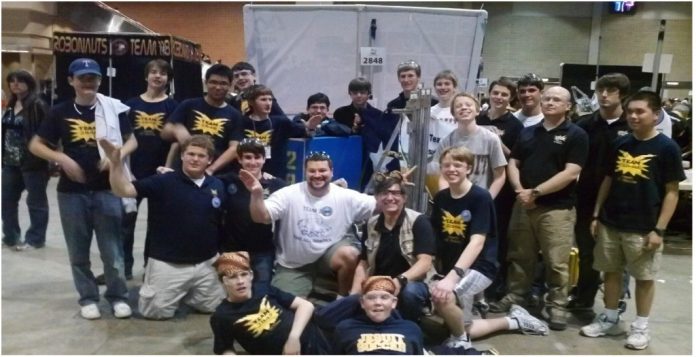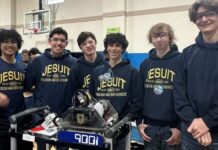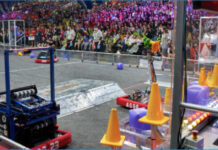As March Madness ensues, sports fans all over America remain attached to their television sets praying their team makes it to the Final Four. The Jesuit Robotics team has had a little March Madness of its own. Jesuit’s robotics team 2848, the All Sparks, competed over this past spring break (March 15th -17th) in the New Orleans FIRST Robotics competition.
Placing 6th in the previous meet in San Antonio, the All Sparks carried their winning spirit into the New Orleans competition, performing better than they had ever before. With their robot, named Bonnie (and practice robot appropriately named Clyde), the team felt confident they could do well in this competition with Michael Gregory ’12 remarking that “the competition was about what we expected based on the scouting data we collected prior to the competition and the statistical analysis of our opponents.” Junior Jeff Barone drove the robot while senior Will Harris operated the shooter and bridge arm, a tandem that had high hopes in New Orleans.
The New Orleans competition was comprised of three parts corresponding to the three days of the competition.
During the first day, teams were required to unload their robots and have them inspected. To compete, teams had to pass inspection, which they were given a whole day to do. The requirements for inspection included rules such as: the robot must be less than 120 pounds; the robot must meet the specified dimensions; the robot must have the right kind of motors; and the robot must be safe, among other rules. After passing inspection, practice matches were held for the benefit of each team.
The next day, the qualification matches started and the competition began. Each robot was randomly put in an “Alliance,” a team of three robots, after which the teams competed until there was a winner. After every match another random robot team was put together, so each team had its own independent record of wins and losses. Lasting the entire day because of the time each match required, anywhere from half an hour to two hours, the preliminary rounds, once finished, served to seed the robots for the real competition that would take place the next day.
On the third and final day of the competition, the top seeded team started the “draft” for elimination-round teams. The top robot club picked the team they wanted to be paired with for the rest of the tournament, the second-seeded robot picked theirs and so on, culminating with the top ranked team having to take the last robot group left to even the playing field. Once all the selections had taken place, there were eight teams of three that would compete in the best two-out-of-three matches until the team with the best record was declared the winner.
After coming in third in the qualification round by winning ten of their eleven matches, Jesuit got the third pick in choosing their fellow robot team, but because the first-placed club took the second place team as their partners, Jesuit received the second pick. Looking back on the moment, Quinn Wolf ’12 recalled that “because everybody knew that we would have the second pick, many teams came up to us and asked us if we would pick them and started bribing us, but we listened to our scout team and made an unbiased and really good decision.”
From there Jesuit “dominated the quarterfinals,” as Wolf described it, easily scoring 50 points- equivalent to about 90 points in a college basketball game. After dismantling that team in two matches and cruising through the first round of the semis, a motor came unplugged in the subsequent round and Jesuit lost one of the matches by a mere point.
With each team tied with one match a piece, a third and final tie-breaking match was required in which Jesuit, as Wolf remembered “fell apart and didn’t do well at all because we had several mechanical issues. What luck.” Despite their successful robot, as Will Harris pointed out, “The other teams did too, making the competition harder.”
Although Jesuit lost the round, the team did manage to get a couple of extra points from the talents of Wolf who made four basketball shots over a 6 foot wall that was over sixty feet away from the balls that went out of play, each basket worth a number of points that was added to the team’s overall score.
Although Jesuit did not win the competition, Patrick Barone ’12 received an Enginering Excellence Award for his end game mechanism design, along with William Ellis ’12, who received the same award for his visual targeting software, an extremely simplified version of facial recognition and color filtering.
Coming this April 3rd Jesuit will be competing in another event at the Dallas Convention Center and the All Sparks would like to see as much Jesuit support as they can get. Show some blue and gold and come on out. Matches start at 9 on Saturday, elimination rounds start at approximately 1! If you want any more information about the team, their website is http://www.jesuitallsparks.org/ and an in-depth video of the details of past competitions can be viewed at http://www.youtube.com/watch?v=nOXsdhZZSdM
As a final note Qunn Wolf “would like to thank [math instructor and robotics moderator ] Mr. Michael Couvillon and mentor Mr. Steve Alaniz for all their hard work as well as all the dads who mentor us. And to our sponsors: JC Penny, Steeline Enclosures, Manda Machine, Karlee, Atmos Energy, Burns Controls, Joral Devices, Solidworks, and Jesuit College Preparatory School.”






